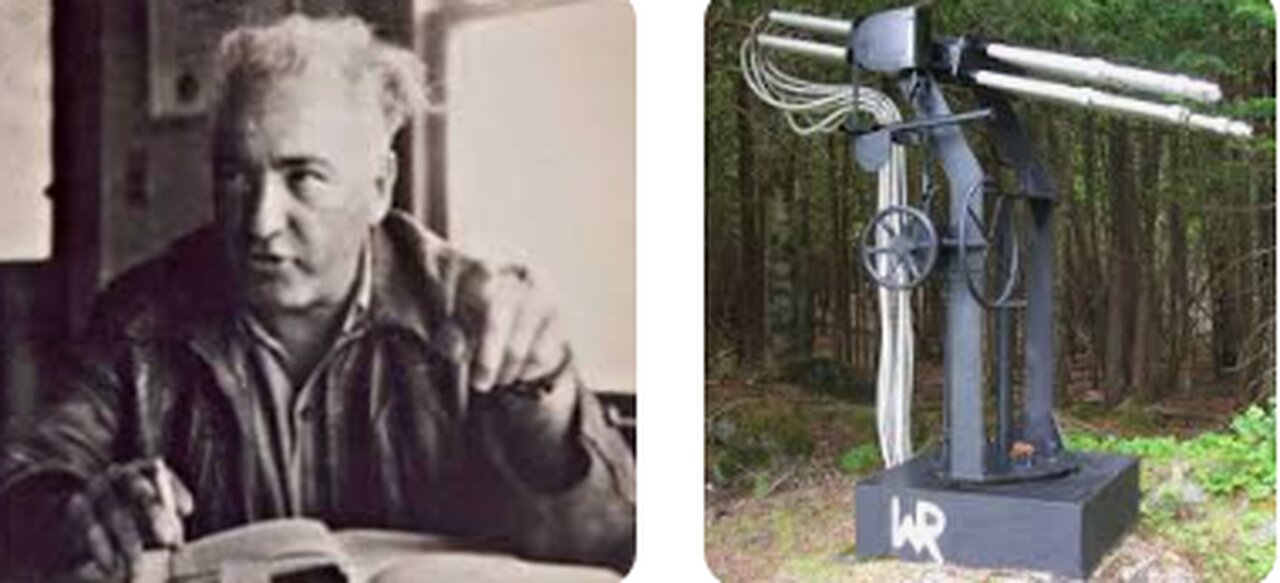Premium Only Content

Wilhelm Reich & the Phoenix Project
The U.S. Government began a weather control project in the late 1940’s under the codename “Phoenix.” The information and technology for this came from Dr. Wilhelm Reich, an Austrian scientist who had studied with Freud and Carl Jung.
Reich was an extremely brilliant man but highly controversial. Although he experimented extensively and wrote many volumes, few of his critics have taken an honest look at all of his research because much of it is not available. Part of this can be attributed to the Food and Drug Administration who supervised a massive book burning of all his available materials and also destroyed much of his laboratory equipment.
Reich was known in part for his discovery of “orgone” energy, which is orgasmic or life energy. His experiments revealed orgone energy to be distinctly different from ordinary electromagnetic energy. He was able to prove the existence of this energy in the laboratory. His findings were written up in various psychiatric and medical journals of the period. The discovery of a type of energy called “orgone” was not so controversial. It became very controversial with the powers at be when he reported curing cancer with his theories. He also associated “orgone” energy with “cosmic energy” and the Newtonian concept of “the ether”. None of these views won him support from conventional scientists of the 1940’s. At the turn of the century, scientists had embraced the Newtonian “ether”. This is referred to a hypothetical invisible substance as a medium for light and radiant energy. Einstein, who embraced the theory in his early years, eventually determined that there could not be a calm ether sea through which matter moves. Not all physicists bought Einstein’s argument, but Reich didn’t disagree. He pointed out that Einstein disproved the concept of a static ether. Reich considered the ether to be wave-like in nature and not static at all.
Conventional scientists have since recognized the existence of phenomena that are a cross between particles and waves. They are sometimes referred to as “wavicles”. Common research has also shown that vacuum space contains complex properties that are dynamic in nature.
Although it is not my cause to take up the case of Reich, his concept of the ether has proven itself functional in my research. It does not matter whether we are actually referring to “wavicles” or even more esoteric phenomena when we talk about the ether. Is is the word that Reich used, and it is easier for me to use in describing this for the general public. The reader is invited to read up on Reich as his work is vast and encompasses much more than can be covered in the scope of this book. For instance, he found practical uses for his theories such as modifying the weather. He found that violent storms accumulate “dead orgone”, which he termed “DOR.” Dead orgone refers to the accumulation of “dead energy” or energy that is on a descending spiral. Orgone and DOR were found to be present not only in biological organisms but in empty regions of the environment as well. An active and enthusiastic go-getter would be considered to have plenty of orgone energy, whereas a complaining hypochondriac who wanted to die would have DOR energy. For example, he found that the more DOR in the storm system, the more violent the storm. He experimented with many forms of DOR busting, and came up with a simple electromagnetic method to reduce the violence of storms. In the late 1940’s, Reich contacted the government and told them he had developed technology that could take the violence out of storms. Despite what disinformation you may hear, the government already knew what Reich could do and considered him a brilliant man. They asked for his prototypes and he was happy to oblige since he wasn’t interested in the mechanical development, just the research.
At this point, the government’s technology team merged Reich’s discoveries with their own weather monitors and produced what is known today as the “radiosonde.”
The government’s contribution to the radiosonde dates back to the “airborne metrograph”
* of the 1920’s. This was a mechanical device that recorded temperature, humidity and pressure. It was sent up in a parachute balloon and recorded information on a paper tape. The balloon was designed to burst so that the parachute would bring the metrograph back to Earth. The public were encouraged to retrieve them for a $5 reward, which was considerably more money in those days. This was how the government obtained data on the weather. The word “metrograph” is more clearly defined if you understand that “metro” signifies that it was a meteorological device and that “graph” means to write.
As these devices were returned via the mail, the time that elapsed before the recorded information could be read was much too long.
In the late 1930’s, a new device was designed that was called a “radio metrograph.” This was similar to the airborne metrograph except that it contained electrical sensors. These sensors were connected to a transmitter that would transmit to a receiver on the ground.
The radio metrograph was the state-of-the-art weather device when Wilhelm Reich contacted the government in the late 1940’s. He gave them a little balsa wood package that could be sent up in a balloon. According to witnesses, approaching thunderstorms actually split up and went around the test sit on Long Island.
The government combined the technology of the radio metrographs with Reich’s DOR busting device and called it the “radiosonde.” It was developed until consistent effects on the weather could be reproduced.
By the 1950’s, radiosondes were being sent into the air en masse at a rate of about 200 per day. Since these radiosondes were sent up in balloons, they would not come down hard enough to self destruct upon impact. The public would find them, and it would be impossible to keep the actual units secret enough without arousing suspicion. They publicized the apparent purpose of recording weather data, which uniformed examination would back up.
The real purpose is not that obvious. If someone tuned into one of these packages, the signal would not appear unusual when normal radio equipment was used. So far so good!
They showed the public a data receiving station; set up to receive the inaccurate and unusuable data. A small production run of this receiving equipment was produced.
There were literally hundreds of these radiosondes in the air every day. With the radio range being limited to 100 miles, there should have been a “pile” of receivers known as radiosonde receptors and they should have been very common. As I am a surplus radio collector “nut”, it is quite strange that I have never seen a radiosonde receptor or the equipment that should accompany one. It is very unusual to have a data transmitter (in this case, the radiosonde) with no receiver to pick it up. This indicates that the Government didn’t use the receivers!
-
 18:23
18:23
Michael Franzese
14 hours agoTom Hardy Is Back — And He’s Absolutely Ruthless | Mobland Review
54.2K8 -
 3:03:30
3:03:30
TimcastIRL
9 hours agoDemocrats Prep Trip To El Salvador To SAVE MS-13 Gang Member, Bring Terrorist To US | Timcast IRL
236K180 -
 2:30:28
2:30:28
Laura Loomer
10 hours agoEP114: Trump Cracks Down On Animal Testing
102K42 -
 2:08:29
2:08:29
RiftTV/Slightly Offensive
10 hours ago $26.62 earnedTexas MURDERER Karmelo Anthony Gets $800K House with GOFUNDME MONEY? | Slightly Offensive
71.6K47 -
 1:13:18
1:13:18
Glenn Greenwald
11 hours agoTrump Meets with El Salvador's Bukele: A Tyrant or a Model to Copy? Plus: Trump's Proposal to Deport Citizens There | SYSTEM UPDATE #439
133K190 -
 14:00:04
14:00:04
MDGgamin
17 hours ago🔴LIVE -TARKOV & Path Of Exile 2- Live Long Enough To Become The Villain. - #RumbleTakeover
34.2K1 -
 2:05:21
2:05:21
Joker Effect
7 hours agoRumble is all freedom of speech! @PlayMotherland and @IGGYAZALEA bring a great genre! The games are lit af!
49.6K1 -
 58:42
58:42
The Amber May Show
16 hours ago $9.21 earnedWomen Of Rumble 04-15-25
65.9K1 -
 4:49
4:49
The Official Steve Harvey
1 day ago $11.94 earnedSteve Harvey's Motivational Talks 💭✨ Dream Big, Work Hard, and Make It Happen! ✨💭
100K7 -
 3:11:08
3:11:08
RaikenNight
8 hours ago $7.04 earnedTime To Go On A Hunt
42.3K2